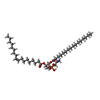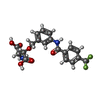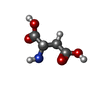+Search query
-Structure paper
| Title | Large domain movements through the lipid bilayer mediate substrate release and inhibition of glutamate transporters. |
|---|---|
| Journal, issue, pages | Elife, Vol. 9, Year 2020 |
| Publish date | Nov 6, 2020 |
 Authors Authors | Xiaoyu Wang / Olga Boudker /  |
| PubMed Abstract | Glutamate transporters are essential players in glutamatergic neurotransmission in the brain, where they maintain extracellular glutamate below cytotoxic levels and allow for rounds of transmission. ...Glutamate transporters are essential players in glutamatergic neurotransmission in the brain, where they maintain extracellular glutamate below cytotoxic levels and allow for rounds of transmission. The structural bases of their function are well established, particularly within a model archaeal homolog, sodium, and aspartate symporter Glt. However, the mechanism of gating on the cytoplasmic side of the membrane remains ambiguous. We report Cryo-EM structures of Glt reconstituted into nanodiscs, including those structurally constrained in the cytoplasm-facing state and either apo, bound to sodium ions only, substrate, or blockers. The structures show that both substrate translocation and release involve movements of the bulky transport domain through the lipid bilayer. They further reveal a novel mode of inhibitor binding and show how solutes release is coupled to protein conformational changes. Finally, we describe how domain movements are associated with the displacement of bound lipids and significant membrane deformations, highlighting the potential regulatory role of the bilayer. |
 External links External links |  Elife / Elife /  PubMed:33155546 / PubMed:33155546 /  PubMed Central PubMed Central |
| Methods | EM (single particle) |
| Resolution | 3.05 - 3.71 Å |
| Structure data | EMDB-21986, PDB-6x12: EMDB-21987, PDB-6x13: EMDB-21988, PDB-6x14: EMDB-21989, PDB-6x15: EMDB-21990, PDB-6x16: EMDB-21991, PDB-6x17: |
| Chemicals |  ChemComp-6OU:  ChemComp-7O9:  ChemComp-NA:  ChemComp-ASP:  ChemComp-HG:  ChemComp-HOH:  ChemComp-TB1: |
| Source |
|
 Keywords Keywords | TRANSPORT PROTEIN / sodium-coupled L-aspartate transporter |
 Movie
Movie Controller
Controller Structure viewers
Structure viewers About Yorodumi Papers
About Yorodumi Papers
















 pyrococcus horikoshii (archaea)
pyrococcus horikoshii (archaea)